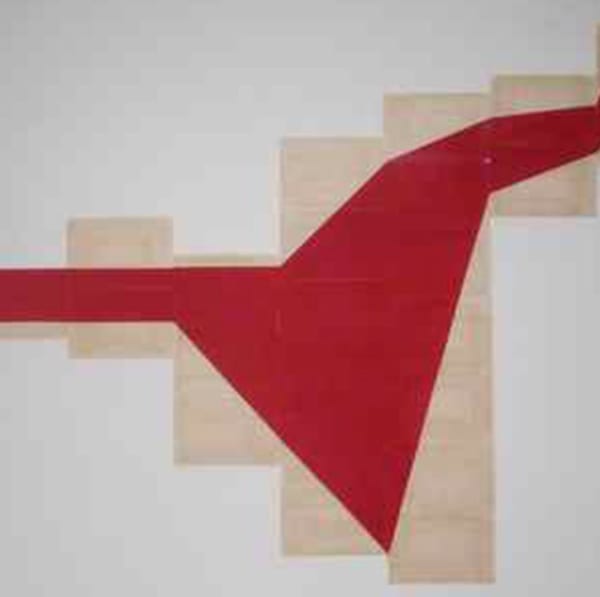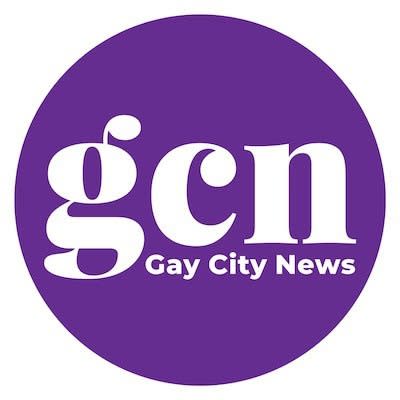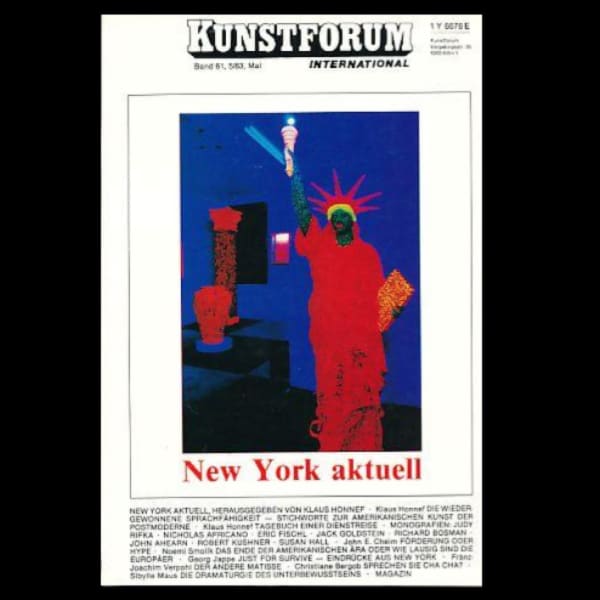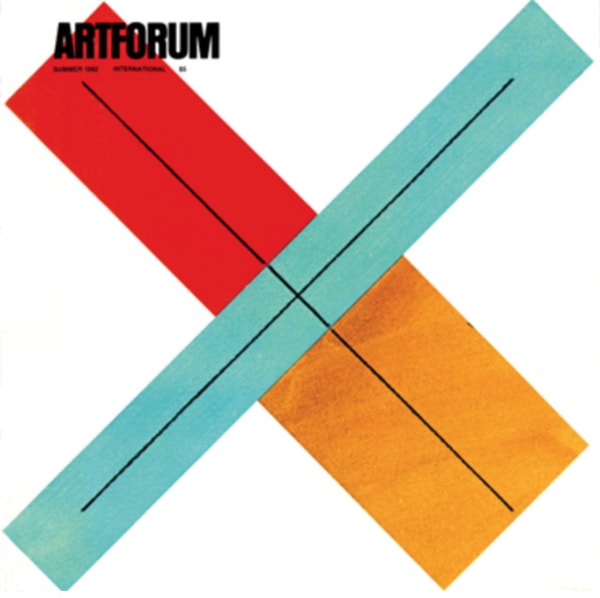-

Judy Rifka Single Shape illustrates Vogel Collection 50x50 Initiative
Shows in Philadelphia and Delaware are part of their "Fifty Works for Fifty States" gift. Jul 11, 2010 Philadelphia, July 11, 2010 The Philadelphia Inquirer uses a Judy Rifka Single Shape to illustrate their article titled 'Art: Vogels'... Read more -

Art in America: Judy Rifka At The Chocolate Factory
by Lilly Wei May 1, 2008 Lilly Wei reviews Judy Rifka's show "Nostos" at the Chocolate Factory in Long Island City: "Judy Rifka's recent exhibition at the Chocolate Factory in Long Island City was her first solo show in the metropolitan area in over 6 years, and one wonders why this talented, volatile artist, associated with the artists' collective Colab and the freewheeling East Village/Lower East Side scene in the late '70s and 80's, has absented herself for so long. The show was titled "Nostos," which is apparently the ancient Greek root from which the word "nostalgia" is derived and means a return or homecoming as well as a species of fish - all of which is appropriate to Rifka's current project." Read more -

Interspecies Travel
by Frank Holliday Oct 3, 2007 Frank Holliday went to see Judy Rifka's latest show at The Chocolate Factory near P.S.1 and wrote a review for Gay City News: "The first time I became aware of Judy Rifka's work was in a show curated by Haring at Ross Bleckner's building that housed the Mudd Club at 77 White Street in Lower Manhattan. The paintings were gray fields with outlined figures floating among geometric dashes. People went crazy for them and she became a major influence in turning the art direction toward post-modernism. She has since had major shows in every museum and is collected around the world. After laying low for a few years, Rifka has chosen to show her recent works, which return to her alternative roots, at an intriguing space out of the mainstream, the Chocolate Factory." Read more -

The Brooklyn Rail: Judy Rifka Nostos
by Cassandra Neyenesch Oct 1, 2007 Cassandra Neyenesch reviews Judy Rifka's show "Nostos" for The Brooklyn Rail: "Since her days at the forefront of postmodern painting in the 80’s, Judy Rifka’s oeuvre has been admirably restless. There is an interplay between subject and expression that makes her difficult to pin down as an artist; sometimes one seems to take precedence and sometimes the other, but they are equally important to her, and this creates a continual tension inside the work. Her new series at the Chocolate Factory demonstrates the complexity of her project. Shapes resembling mangled abattoir leavings are painted in livid reds and bone-blues and dark purples on natural linen, then the painting is cut out and glued to another piece of linen. Smaller canvas collages are more restrained, made of cut-out circular shapes that seem to refer both to an older obsession of Rifka’s with classicizing forms and to the Russian Suprematists." Read more
-

Charlie Finch suggests Judy Rifka for another Whitney Show
"The Unfinished Woman" Aug 1, 2004 Charlie Finch wrote a new piece titled Wishlist for the Dog Days for Artnet suggesting Judy Rifka should get another showing at the Whitney: "The Unfinished Woman" In light of the moronic tits and ass now infecting Reality Show America, it's time to return to the feminist pioneers of post-war USA and select some outstanding works of liberation, femme style, from the forgotten past. Artists could include Joan Brown, Hannah Wilkie, Rebecca Howland, Moira Dryer, Ree Morton, Ellen Berkenblit, Judy Rifka, Judy Pfaff, Cady Noland and so many others. Read more -

Grace Versus Grunge
Charlie Finch calls Judy Rifka "Forgotten Genius" Feb 1, 2004 Charlie Finch mentioned Judy Rifka in his latest Artnet Feature: "Nope, the messiestas often do a lot of harm when their turn again comes around. Thousands of them on the East Village scene trampled a few forgotten geniuses such as Judy Rifka, Stephen Lack and Luis Frangella, and the LFL brigade is determined to bury fine formalists like Kurt Kauper or Will Cotton with the undisciplined vomit of Danica Phelps." Read more -

Artforum: The Rite Stuff
by David Frankel Jan 1, 2003 David Frankel discusses the history and contribution of Art-Rite to the art world for Artforum including Judy Rifka's contribution to the magazine: In this and the next two issues that year, these lists included Vito Acconci, Lawrence Alloway, Laurie Anderson, Eleanor Antin, Richard Armstrong, Rudolf Baranik, Gregory Battcock, David Bourdon, AA Bronson, Trisha Brown, Scott Burton, Lucinda Childs, Colette, Diego Cortez, Jeffrey Deitch, Richard Foreman, Hans Haacke, Alanna Heiss, Rebecca Horn, Neil Jenney, Bill Jensen, Jill Johnston, Joan Jonas, Lucy Lippard, Mabou Mines, Brice Marden, Annette Michelson, Elizabeth Murray, Steve Paxton, Robert Pincus-Witten, Yvonne Rainer, Robert Rauschenberg, Judy Rifka, Susan Rothenberg, Irving Sandler, Julian Schnabel (in 1975 Schnabel was twenty-four, and probably still working as a burger cook), Carolee Schneemann, Joan Simon, Jack Smith, Patti Smith, Holly Solomon, Nancy Spero, Alan Suicide, John Torreano, Hannah Wilke, Robert Wilson, Robin Winters, and many others both less and equally well known. As early as 1976, David Salle was writing for the magazine. It was a catholic community. Read more -

Jorge Galindo - Pintura animal at Museo Reina Sofia
9 March 1999 - 7 April 1999 Mar 9, 1999 Jorge Galindo's "Pintura animal" will be on view at the Museo Nacional Centro de Arte Reina Sofía from March 9, 1999 to April 7, 1999. This series of seven paintings critices "the false interpretation of abstract painting, the excess in domestic decorative order and the abundance of images that surround contemporary humans". The series depicts dogs and other animals that are complemented by naked female or male torsos, thus causing a feeling of displacement and discomfort with the viewer. Criticizing mass culture, the paintings highlight the lack of filters by the reader and consumer. Read more
-

Art in America: Judy Rifka At Alley Culture
By Vincent Carducci Jan 1, 1998 Vincent Carducci discusses Judy Rifka's exhibition of her "Pet Boy" series at Alley Culture: The "Pet Boy" motif, a cartoonish cat-headed male figure often rendered seminaked, made its first appearance in Rifka's work in the late 1970s. At that time, she adopted a feminist position which led her to appropriate techniques of the male gaze as an art strategy. Here the "Pet Boy" installation comprised dozens of outlined figures in several standardized poses, each mechanically reproduced on 5-by-S-inch card stock, arranged on the wall in floor-to-ceiling rows. The figures were hand-painted in a rainbow of flesh tones as a multicultural array of exotic yet commodified objects of desire. A Neo-Classical pattern on the banding of the underwear worn by many of the "Pet Boys" looks to have been derived from a Gianni Versace ad. Read more -

Judy Rifka features prominently in MODERNITIES: Art-Matters in the Present
by Joseph Masheck Feb 9, 1993 Former Artforum editor Joseph Masheck has published a new book which explores the open-ended possibilities of abstract painting in 30 essays and reviews: "Sampling the neoexpressionist flowering on Manhattan's Lower East Side, Masheck singles out Judy Rifka's archly iconoclastic urban dystopias and Sigmar Polke's Pop-imbued abstracts." Read more -

Judy Rifka And “Postmodernism” In Architecture
Art in America, December 1984 Dec 1, 1984 Judy Rifka’s “A. Museum”, 1982 adorns the cover of the December 1984 issue of Art in America and is accompanied by a 16-page article by Joseph Masheck: “Using Rifka’s Parthenon paintings as his prism, the author illuminates many moments in the strange family of classicism, examining works from Mannerism to Minimalism, Pop to the present. Like some classicizing art today, the result is a tour de force of references.” Read more -

Judy Rifka and Van Gogh
Ronny Cohen for Artforum September 1984 Sep 1, 1984 Like Van Gogh, Rifka represents the universal dynamism of nature in the very interstices of the painting: what he did with his wonderfully fibrous brushstrokes, she does with the psychologically imposing physicality of her relief structure. Read more
-

Glenn O’Brien discusses Judy Rifka’s contribution to Colab, “A More Store”
Colab, "A More Store", takes place at Jack Tilton Gallery Mar 1, 1984 Artforum's March 1984 issue sees Glenn O'Brien discuss Judy Rifka's contribution to Colab, "A More Store", at Jack Tilton Gallery Read more -

Kunstforum: Judy Rifka is New York
A lively, active woman who immediately captivates you in every way. May 1, 1983 The May issue of Kunstforum explores the contemporary art scene of New York and concludes that Judy Rifka is the quintessential New York artist: "Judy Rifka, a lively, active woman who immediately captivates you in every way, who at times seems like a personified New Yorker and conveys something of the aura, hecticness, excitement, but also the wit, the nonchalance, the quick-tempered cleverness of this city, sees herself as an outspoken representative of the post-minimal era." Read more -

Jeanne Silverthorne highlights lack of women in "The Pressure To Paint" show
Says Judy Rifka should have been paired with David Salle Oct 1, 1982 There are no women in the show. ... there are plenty of women who would have more than held their own in the visual pairing done here. Along with Baselitz/Schnabel and Haring/Penck, there could have been Judy Rifka/Salle, Austé/Haring, Louisa Chase/Cucci, Pat Steir/Kiefer, and Joan Snyder/Schnabel, to name but a few. Read more -

Judy Rifka in Artforum September 1982
Article by Edit deAk Sep 1, 1982 From Bruce McLean’s man holding up a tape measure through the sci-fi figures of Keith Haring, to Judy Rifka’s acrobatic females . . . and, yes, we have boxers, saints, wimpy winners, sports champs, and headhunters, we’ve even got crucifixes and Jonathan Borofsky’s colossi. Why, it’s enough to make you throw up your hands. And, ladies and gentlemen, don’t worry, we make connections. We’ve got your late-night urban white girl tangled up with the black-man myth (Elvira Bach), and in the next room we’ve got paintings by the Black Man Himself, Jean Michel Basquiat. Read more
-

Dancers, drummers, posers - a veritable New York cast features in Judy Rifka's latest paintings
Kate Linker for Artforum Summer 1982 Jun 1, 1982 But most important are her characters—a veritable New York cast. Most step out of the rock clubs; there are dancers, drummers, posers. And many are femmes fatales—racy ladies with high-heeled shoes, who strut their stuff and perform. These figures run and jump, cavorting across the canvas, or swoop in from the wings—from offstage, “real” terrain. And while some are punk priestesses, still others are graffiti guerrillières armed with spray cans. Whoever’s on the scene, supposedly, is there. Read more -

The Radiant Child
Artforum, December 1981 Dec 1, 1981 The Artforum December 1981 issue featured a landmark essay about the East Village gallery scene of the early 1980s by Rene Ricard. Asking the question “What is it that makes something look like art?”, the essay is nowadays considered a seminal text in contemporary art criticism. Read more -

Artforum Summer 1981: Rene Ricard on Julian Schnabel and Judy Rifka
Article titled Not About Julian Schnabel Jun 1, 1981 Rene Ricard revises his opinion of Julian Schnabel's work in his latest Artforum article that is full of praise: "I never cared for Julian’s work and still ain’t crazy about the drawings. When I saw the first plate however I realized that here was something I had to come to terms with, that I somehow had a responsibility to it, pushing as it did so much else into the back of my mind, as a new love will erase a difficult love one has been battling. And now as the etiolated American hegemony withdraws we see, as Judy Rifka sees, a great world of art blooming in perfection and Julian wielding his great artillery in the setting of the American sun." Read more -

Judy Rifka's triptych Confused features in MoMA Penthouse
New Art II: Surfaces/Textures runs from Mar 26 - Jun 9, 1981 Mar 26, 1981 Judy Rifka is contributing a large scale triptych ot New Art II: Surfaces/Textures, the second in a series of Penthouse exhibitions presenting new perspectives in contemporary art. Read more
-

Review of Judy Rifka's show in Artforum November 1980 issue
Joan Casademont reviews Judy Rifka at Braathen-Gallozzi Contemporary Art Nov 1, 1980 Eclecticism—not to be confused with this year’s fashion—informs Judy Rifka’s painting from the series, “80 Views of West Broadway.” Rifka doesn’t rehash old points, though her approach shows a careful consideration of color and form. The catch is that the work appears very contemporary, since its “accessibility” carries a distinctly New Wave sensibility. Read more -

Artforum February Issue Features Judy Rifka in Centerfold
Intro by Ingrid Sischy Feb 1, 1980 Judy Rifka takes an Artforum Centerfold 4 page spread in the February 1980 issue. Read more -

Judy Rifka in Rooms at MoMA P.S.1
Group show runs form June 9 to June 26, 1976 Jun 9, 1976 Rooms at MoMA P.S.1 explores works by artists such as Vito Acconci, Carl Andre, Richard Artschwager, John Baldessari, Daniel Buren, Walter De Maria, Joseph Kosuth, Bruce Nauman, Dennis Oppenheim, Nam June Paik, Judy Rifka, Robert Ryman, Richard Serra, Richard Tuttle and Lawrence Weiner. Read more -

Judy Rifka - Artists Space
Susan Heinemann for Artforum May 1975 May 1, 1975 Artforum's May 1975 issue features Susan Heinemann's review of Judy Rifka's latest paintings Read more
Page
3
of 3

























